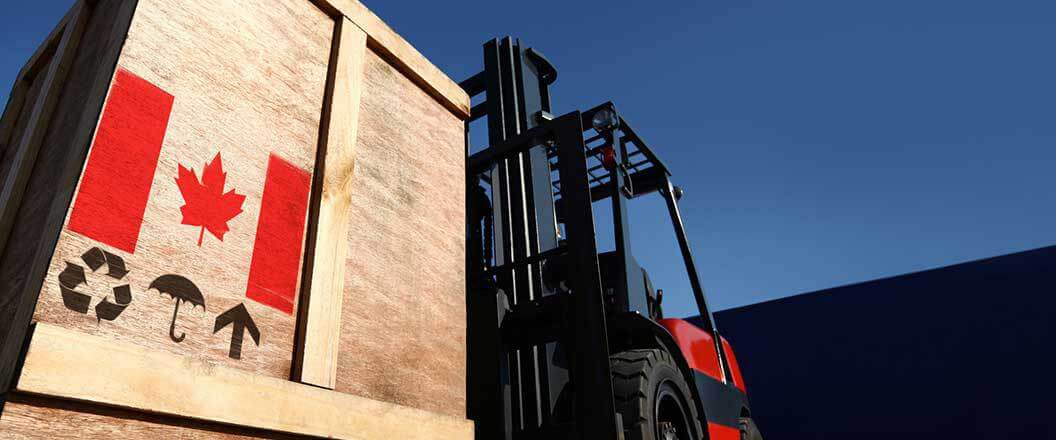Exporting to Canada might seem like an easy task considering the distance relative to the United States. However, there is little difference in terms of what is required when exporting to Canada versus places like Australia other than the distance.
Canada is a lead partner when it comes to import/export trade. Proper filing with the Canadian Border Services Agency (CBSA) and partner agencies are mandatory. Schedule B codes and ECCN numbers are also mandated, so attention to detail is critical when exporting.
Exporting goods into Canada takes some careful preparation and planning. The guide below offers a clear insight into how to get your goods shipped to Canada.

An agreement between President Trump and Canadian Prime Minister Justin Trudeau has resulted in another month-long tariff break, for a limited number of products. Until April 2, imports from Canada that are specifically granted duty-free entry under the USMCA treaty will get a reprieve from the 25% tariff.
Historically, Canada’s top imports from the United States have vehicles, car parts, and petroleum.
On February 1, 2025, President Trump moved forward with the proposed tariffs on goods from Mexico, Canada, and China. The tariffs fall in line with his America First Trade Policy and will remain in effect indefinitely, or until removed by the president.
This means that goods imported from Canada will be subject to a 25% additional ad valorem duty, except energy or energy resources, which will be charged at 10%
No specific HTS code list accompanied any of the three new executive orders, so importers should expect that the import of any product intended for consumption in the U.S. will be subject to the additional tariff.
As of February 3, 2025, President Trump and Prime Minister Trudeau have reached an agreement that will delay the implementation of these tariffs for 30 days.
In addition to the ad valorem tariffs being applied to imports from each of the three nations, there are other provisions written into each order to provide clarity on specific exceptional situations.
All orders were pushed through as part of a national emergency under the International Emergency Economic Powers Act (IEEPA) and the National Emergencies Act.
Any retaliatory tariffs have been suspended along with the initial 25% proposal from the Trump administration.
Canada is currently one of the top trade partners with the United States. In 2021, a trade report outlined how the annual export trade peaked at $1.9 trillion. Canada shored up $308 billion of that total, an increase over 2019 $293 billion export trade.
This statistic outlines the importance of doing business up north for American exporters. The desire for US exports in Canada is at an all-time high, and it’s the number one importer of US goods as of 2021.
| Country | Amount in US Exports |
| Canada | $308 Billion |
| Mexico | $276 Billion |
| China | $151 Billion |
| Japan | $75 Billion |
| The United Kingdom | $61 Billion |
While other nations like Mexico, Japan, China, and the United Kingdom enjoy importing goods from the US, Canada has many advantages for US exporters. Like Mexico, Canada rests on the border with the US, making exporting a snap with a fast turnaround time.
The proximity of the US and Canada makes for a highly profitable enterprise between the two nation-states. Besides the distance factor, Canada is culturally similar to the US, making it very easy to do business there for American exporters.
According to the International Trade Administration (ITA), the Canadian people import around $1.7 billion of American products daily, per the International Trade Administration (ITA). It is also worth noting that out of the entirety of the Canadian population, around 60% of their income is spent on US goods.
Over the years, the US, Canada, and Mexico have etched out an agreement known as the United States of America, Mexico, and Canada Agreement (USMCA) which encourages competitiveness, lowers barriers of entry framework, and fast moving exchanges of products.
If you’re exporting to Mexico or Canada, our article on the benefits of USMCA will help you out.

As it was noted earlier, the US and Canada are culturally similar. This statement also runs into laws and politics. Generally speaking, if the goods and services are legal here, they are legal for export into Canada. However, you should always check with a consultant beforehand.
Just like the US, Canada has a very open-minded trade program. However, trade licenses and stiff import regulations are required for certain goods imported into Canada. Under Canada’s Export and Import Permits Act, certain exports require a license or export permit, such as alcoholic beverages.
Specific regulations exist for goods such as:
The Safe Foods for Canadians Regulations (SOR 2018-108) are in place, functioning similarly to the US Food and Drug Administration (FDA) regulations.
It is essential to understand that the North American Free Trade Agreement (NAFTA) is no longer in place and that the USMCA has replaced it. The reasoning for this initiative was to bring the trade agreement into the modern era.
Some of the benefits of USMCA are as follows:
USMCA has indeed loosened the reins on trade requirements and restrictions on certain goods like agricultural products. The de minimis rule was also raised under USMCA to serve US exports better.
At the same time, dairy farmers and other agricultural exporters have more open access to the Canadian market than ever before. The automotive industry has seen a boost in labor due to parts distribution.
It is essential when exporting to know and understand how the USMCA trade agreement affects your business and the goods and services you are shipping to Canada. In any case, seek the help and guidance of an export consultant to clear up any confusion or get the advice you need.
One popular good traded between Canada and the U.S. is prescription drugs. If you want help exporting prescription drugs from the U.S., check out our article on the topic.
Canadian imports rely upon many categories of US goods annually. Knowing which trade goods are most desired in Canada is critical for anyone looking to export goods from the US.
Some of the most prominent exports from the US to Canada are the following:
These categories are just a sample of types of goods that dominate the US export business with Canada. Renewable energies and various forms of machinery also hold considerable weight in their desire among Canadian firms.
In short, the changes installed after NAFTA was dissolved and the oncoming entrance of USMCA made exporting to Canada more advantageous.

When exporting goods across the northern border of the US to Canada, there is required documentation. Also, compliance with Canada’s import laws is required before exporting goods.
It is essential to ensure the correct Export Control Classification Number (ECCN) of your goods being exported to Canada. This number is similar to a Schedule B number in the concept of proper goods classification.
However, in this instance, the Canadian export controls handbook has all the information about your exported goods. You are required to have two documents completed and ready for submission:
Compiling all documentation to comply with the CBSA and any other partnering agency when exporting goods into Canada is essential. The list of documents above is required to be completed in the utmost detail.
To best facilitate your exports, you should speak with a consultant to plan your course of action. You then can pair up with an experienced foreign broker who will manage the shipment of goods into Canada.

There are a series of steps associated with exporting goods to Canada successfully. All steps must be followed to avoid any issues that may arise. To ship goods to Canada without any problems, follow the steps below.
The primary agency service office you will be dealing with is the CBSA. Similar to the US Customs Border Protection Agency (CBP), the CBSA facilitates border laws, customs, and regulation of goods into the country.
Step 1: You must complete a business number registration to ship goods. This registration is a mandatory step by the Canadian Revenue Agency (CRA).
Step 2: Not all goods are eligible for export into Canada. Check goods eligibility, accurately describe your goods, and have manufacturer information readily available.
Step 3: Check the Import Control List, and obtain all import permits, so your goods are eligible for importation into Canada.
Step 4: Check to see if your goods are prohibited, controlled, or regulated by Canadian Federal agencies and partner agencies before exporting.
Step 5: At this point, you will need to figure out the tariff classification for your goods. HTS codes are the most accurate way of determining tariff rates. You can use a Schedule B Code found on the Census Bureau’s website, but it may differ slightly
Step 6: Find the duty rate, value, and associated taxes or fees with your exported goods. Consult with a specialist if you have never before performed these steps.
Why is the use of an export consultant so important? Using an export compliance specialist is always the safest and best bet when exporting goods into Canada. Besides ensuring a smooth process, they prepare and facilitate all documentation required.
Export services also communicate and work directly with the CBSA to ensure the exporting process completes without any issues.
An export specialist can assist in:
As you can see, the details associated with exporting are vast and numerous. Following each step to the letter is essential, as one missed step can result in detrimental failure. A single loss can become quite costly as one mishap can spawn others.
For this reason of correctness, you should always seek out consultation, at the very least. Ultimately, it is most advantageous to seek out an export specialist when dealing with goods you wish to export to Canada.
The following Canadian government partner agencies administer regulations and control prohibited goods in Canada.
The outlined partner agencies listed represent the core of secondary agencies that may or may not have a direct hand in your exports. It is critical to do your due diligence and decipher whether or not one of these agencies has dominion over the goods you are exporting.
In most situations, there is a partner agency that might require an additional step or policy adherence for the goods you are exporting. Do not assume that nothing extra is required of you because that will most certainly lead to delays, seizures, or even fines.
It is always best to consult an expert to see what steps of additional provisions you may be required to take in any event. It is always better to be safe than sorry, especially when dealing with international trade.
As it has been outlined in this article many times, exporting is lengthy, detailed, and exact in terms of deployment and execution. Your export strategies must be just as competitive as when striking deals in the business world.
Cargo Export USA is your one trusted export partner who offers peace of mind when shipping goods internationally while delivering world-class service to all our customers. Our friendly and knowledgeable staff is available anytime to help facilitate all of your export needs.
To help make your next export venture a success, consider using the following services:
Our team at Cargo Export USA is deeply committed to your needs. No export task is too big or too small for us to handle; your business is our business. You can click or call us today at (866) 301-0635 for more information or assistance.